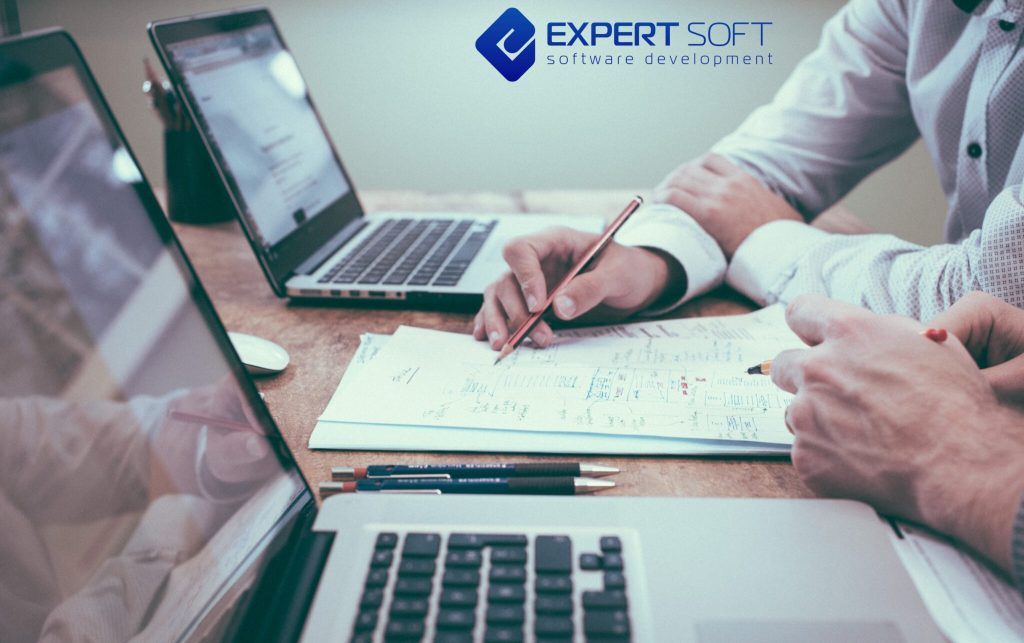How to Build the Best Custom ERP Software Using Java – A Complete Guide on Custom Java Software Development for Businesses

Enterprise resource planning (ERP) is software that is developed to manage from one place the whole chain of business processes. This may include logistics, human resources, accounting, inventory management, etc. The popularity of ERP has skyrocketed over the recent years, and it is expected that by 2024 the ERP total market size will reach $97.15 billion.
Modern ERP software can be customized to any industry. Another advantage is that it cuts down business operating expenses nearly automatically. What is more, custom ERP developers can help you build custom software that will optimize resources, make your business cost-effective, and eliminate risks.

Out-of-the-box ERP software is made for the mass market, thus it gives no or a small number of customization opportunities. Thus, you would have to have to adapt such software to the processes of your company. It will be time- and money-consuming to train employees. Custom ERP, on the other hand, is meant to comply with your company’s business processes and become more convenient for work.
In this article, I am about to give you an overview of building an ERP from scratch and outline the main steps of ERP development using Java.
Why develop custom ERP?
- Because you don’t have quick access to crucial business data.
ERP development keeps all databases together and gives you a tool to control business efficiency at numerous levels. Ready-made solutions can’t consider all business factors and require manual interaction. An automated custom ERP, on the other hand, provides you with a picture of what’s going on in real time.
- Accounting problems.
If sales orders and invoices processing are too time-consuming for your accountants, and you haven’t found an automated tool that meets your requirements, go for custom ERP software development. It will help you maintain financial data and increase the productivity of your accounting staff.
- Bad customer experience due to constant inventory management problems.
If your selling, supply, storage, production, and delivery departments do not use a unified database where they can control orders, you may have order deadline violations because departments are overloaded.
With a custom ERP, you will be able to control order processing and each manager will be aware of the process. What is more, you will have a chance to automate material maintenance contracts between you and your suppliers.

How to build your own ERP system?
- Clarify your requirements and define who your software consumer is.
To get the best quality, you should transparently define what your requirements for the development team are. To get ready with your requirements, you need to know why you need a custom ERP in the first place. Do you need a custom tool or out-of-the-box software? Or, maybe you want to combine ready-made ERP solutions with custom software. Think about your budget and what you want to get from this software. Then, define the departments and workers who will be using ERP. This will influence the choice of items you need to include in ERP software. You may have some specific requirements but most businesses need the following items to be included in their ERP software: Sales, Financing, Distribution or Delivery, HR.
- Define functionality and ERP system design development.
The next step is to decide whether to work with an in-house team, an outsourcing one or choose a hybrid approach. Each of them has its strong and weak sides. We outlined their benefits and risks in our blog article so that it can be easier to make up your mind.

Let’s say you’ve determined the type of the team you’re going to cooperate with. Then you should work on custom ERP functionality with them. Begin with compiling a list of requirements and then go on with project documentation. Your tech document should include such features as description, programming languages, platforms, required integrations, potential future product capacity, project deadline, and other relevant details. Make UI/UX design user-friendly and transparent. ERP software usually has several user roles, charts, numerous navigation buttons, and other elements.
- Choose a tech stack.
The choice of the stack depends on the platform you create it for. So, for example, for desktop platforms, developers are more likely to use C++ or C# and Objective-C or Swift. For the web version – Angular, JavaScript, and Node.js. Front-end technologies may include Angular JS, React, Vue.js, Javascript, etc. Back-end technologies – Java, Node JS, Python and others.
- Include ERP modules.
During the ERP application building process, it’s not uncommon to use numerous third-party integrations, such as SAP, G Suite, Office 365, Jira, Salesforce, and others. Different APIs from third-party services are used to access the data and display it in the ERP system.
- Testing, improvement and feedback collecting.
Check whether the team has managed to match initial functionality, security, and integration requirements. Perform accounting or sales operations to test the ERP’s functionality. Estimate the accuracy of the results that the system gives back. Work with focus groups to test dedicated modules. To test how various modules work together, ask some people from the target department to use the modules and get their feedback to plan tool updates and estimate the benefits you are getting from ERP. Run security testing to find and fix all the bugs.

What are the benefits of custom ERP?
- Pay only for the features you need. When using out-of-the-box ERP, you are paying for the whole package no matter whether you use it or not. With custom ERP, only required features are included.
- Add extra features and test. You develop your ERP step-by-step and carry out testing at each stage. If you need extra features in the future, you can add them anytime. You also choose the design, languages, and can use internal analytics to be sure that everything works great.
- Scale your ERP easily. Working with custom ERP, gives you the flexibility to scale it anytime you want and be ahead of your competitors. Or, on the other side, you can move to another provider if the current one doesn’t meet your requirements.
- Improve collaboration. Your employees can have better collaboration because of having access to all necessary company data instead of using different databases for each department.
- Automate business processes. Using ERP will help to put the internal processes of the company on autopilot. This includes financial management, human resource management, customer relationship management and so on and so forth.
- Simple interface. There are a few users that will work with the ERP software from time to time. It is important to make their work as simple as possible, so they don’t need to ask someone else each time they need to work with the system. With custom ERP, you can create a way of keeping your employees in mind. Whereas, in the case of out-of-the-box ERP, you have to use the same as developed by the company.
How much does it cost to build your own ERP?
The cost of ERP development depends on several factors: the number of departments that are going to use ERP software and the functionalities the system will possess. There is no such thing as a one-size-fits-all ERP. The cost can vary a lot, from $20,000 to many millions. Large enterprises will pay more than small businesses because they need more users and wider functionality.
You can predict an average cost and choose a reasonably priced option by:
- 1. Determining the number of users. You will be charged at least $400 per user per month, so it’s possible to calculate the final price based on your company size. Custom software may turn out cheaper.
- 2. Ensuring that the list of features includes only essentials. Many companies who choose the “I need them all” approach tend to overpay for ERP software because they simply don’t use all the features they paid for. The number of features influences the price so examine this topic scrupulously. Before contacting development teams, create a detailed plan of apps and modules you need.
- 3. Choosing the best price-quality ratio. When outsourcing your ERP development, you can compare prices offered by different providers and choose the option with the high quality of the ready product, sufficient amount of features and a reasonable price.
Do not forget about ongoing support costs. To keep your ERP afloat, you should continuously spend money on its maintenance and constant updates. But there are some tips to minimize these costs:
First things first, you can outsource ERP maintenance. When working with an in-house team, you spend a lot of money on training and employment. Working with an outsourcing team can be more affordable. Secondly, customize your software. The more it is tailored to your needs, the fewer updates and changes you need. Last but not least, exclude the functionalities you don’t need from your provider’s support package and negotiate a lower price.

When building an ERP from scratch, you may be wondering what the key features of your custom ERP software should be?
Many people are aware of the saying “Keep it simple, stupid”. This rule can be efficiently followed during the process of ERP development. You should help people not waste their time deciding what to choose from the menu to perform the functions they need. The more basic the interface – the easier it will be for employees to work with it. Data-collecting and data-management processes should be straightforward and fast. Keep your system less crowded and make your software development team work on user experience.
How to choose your technology partner for ERP development?
Developing ERP software is an expensive task. So it may be quite useful to follow some steps to minimize the costs and get the best price-quality ratio:
- Choose a company with experience in ERP development. You may like the company with the positive reviews from customers but this company may have no expertise in successful ERP development. So, go for a software development team that has already worked on ERP design in your market area.
- Work with an Eastern European outsourcing company instead of hiring an in-house development team in your country. The rates of professionals in Eastern Europe are usually significantly lower than those in the USA or other developed countries. But what is more important, you will get the same quality of the final product and get access to a greater talent pool as you are not limited by your geographical position. Of course, it’s up to you to decide what suits your business needs more. But outsourcing can definitely be a thing to consider when developing ERP software from scratch or just having a necessity to get ongoing maintenance.
- Evaluate cultural background and English-speaking skills. As was mentioned in the previous paragraph, it can be profitable to work with an Eastern European company. But not only because you are going to get lower prices and top quality of the final product. But also because you won’t face any cultural misfit since you are working with people of the same mentality. Check their English-speaking skills so you can be sure you will be able to have transparent communication with the team while working on the project.
To wrap it all up, we’ve outlined the main steps on how to build an ERP software from scratch and the most useful tips on how to make it the most time- and cost-effective way. It’s smart to keep in mind that in order to minimize the price and get the top quality of the final product, you should choose only those features that will come in handy for your employees and keep the ERP simple, user-friendly, smart and straightforward.
As for choosing the team for this complicated task, it’s up to you to decide which approach will better suit your needs. The more important thing is for your team to have experience in your market area and be able to comply with the requirements you set at the stage of hiring them. If after reading our overview, you still have some answers or want to clarify some steps, you can always contact me and I guarantee you my help.
New articles

See more

See more

See more

See more

See more
